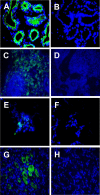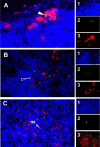Reactivation of Simian Varicella Virus in Rhesus Macaques after CD4 T Cell Depletion
- PMID: 30404798
- PMCID: PMC6340024
- DOI: 10.1128/JVI.01375-18
Reactivation of Simian Varicella Virus in Rhesus Macaques after CD4 T Cell Depletion
Abstract
Rhesus macaques intrabronchially inoculated with simian varicella virus (SVV), the counterpart of human varicella-zoster virus (VZV), developed primary infection with viremia and rash, which resolved upon clearance of viremia, followed by the establishment of latency. To assess the role of CD4 T cell immunity in reactivation, monkeys were treated with a single 50-mg/kg dose of a humanized monoclonal anti-CD4 antibody; within 1 week, circulating CD4 T cells were reduced from 40 to 60% to 5 to 30% of the total T cell population and remained low for 2 months. Very low viremia was seen only in some of the treated monkeys. Zoster rash developed after 7 days in the monkey with the most extensive CD4 T cell depletion (5%) and in all other monkeys at 10 to 49 days posttreatment, with recurrent zoster in one treated monkey. SVV DNA was detected in the lung from two of five monkeys, in bronchial lymph nodes from one of the five monkeys, and in ganglia from at least two dermatomes in three of five monkeys. Immunofluorescence analysis of skin rash, lungs, lymph nodes, and ganglia revealed SVV ORF63 protein at the following sites: sweat glands in skin; type II cells in lung alveoli, macrophages, and dendritic cells in lymph nodes; and the neuronal cytoplasm of ganglia. Detection of SVV antigen in multiple tissues upon CD4 T cell depletion and virus reactivation suggests a critical role for CD4 T cell immunity in controlling varicella virus latency.IMPORTANCE Reactivation of latent VZV in humans can result in serious neurological complications. VZV-specific cell-mediated immunity is critical for the maintenance of latency. Similar to VZV in humans, SVV causes varicella in monkeys, establishes latency in ganglia, and reactivates to produce shingles. Here, we show that depletion of CD4 T cells in rhesus macaques results in SVV reactivation, with virus antigens found in zoster rash and SVV DNA and antigens found in lungs, lymph nodes, and ganglia. These results suggest the critical role of CD4 T cell immunity in controlling varicella virus latency.
Keywords: CD4 T cell depletion; animal model; simian varicella virus reactivation.
Copyright © 2019 American Society for Microbiology.
Figures






References
-
- Levin MJ, Smith JG, Kaufhold RM, Barber D, Hayward AR, Chan CY, Chan IS, Li DJ, Wang W, Keller PM, Shaw A, Silber JL, Schlienger K, Chalikonda I, Vessey SJ, Caulfield MJ. 2003. Decline in varicella-zoster virus (VZV)-specific cell-mediated immunity with increasing age and boosting with a high-dose VZV vaccine. J Infect Dis 188:1336–1344. doi:10.1086/379048. - DOI - PubMed
-
- Hess TM, Lutz LJ, Nauss LA, Lamer TJ. 1990. Treatment of acute herpetic neuralgia: a case report and review of the literature. Minn Med 73:37–40. - PubMed
Publication types
MeSH terms
Grants and funding
LinkOut - more resources
Full Text Sources
Research Materials

